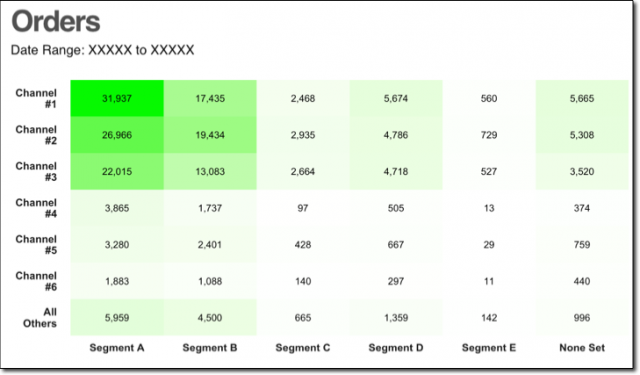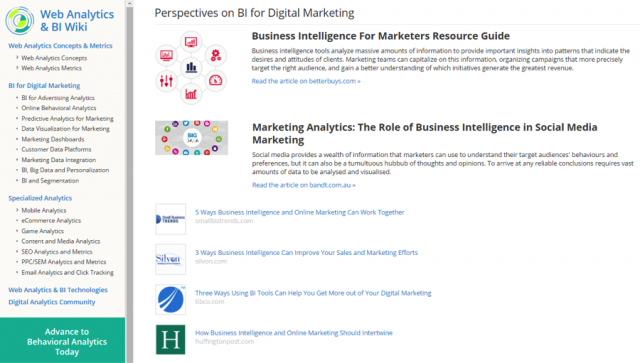Of these 3 job titles, how would you describe yours?
If you work in a very small company, you’re probably a jack of all trades trying to survive and be successful, and if you are reading this website you recognize that in order to do that you must be data-driven. You have Google Analytics, maybe Hubspot, some data from your back-end systems and CRM, and you probably have a treasured spreadsheet in which all that data comes together to report to management.
If you work for a larger company, your job title might be web analyst, and there may be an entire team of analysts or conversion experts who plow through Google Analytics reports, alongside tools like Optimizely, Mixpanel or Clicktale. You come up with great ideas on how to convert more site visitors, improve revenue or fix glaring problems on the website or web app.
If you are in a really big company, you (or some of your colleagues) might be a BI analyst or a Data Scientist (the world’s new sexiest job title). You work with tools like BigQuery, Hadoop or Tableau, and you can generate some really cool-looking charts based on huge amounts of data and provide deeper insights into what users are actually doing, why exactly they are churning or paying, and how to drive optimal outcomes. When you need to, you write code in Python or R and use advanced statistical and machine learning techniques to analyze data in ways that were previously impossible.
This was, until recently, the state of the industry. But it’s changing. Quite soon, the online marketer will be a web analyst, and a data scientist too. She won’t be able to move the needle without understanding the sort of things you see on a Tableau dashboard. A web analyst will need to live and breathe big data to answer the questions being asked by the business. And data scientists won’t have the luxury of analyzing data for weeks to come back with million-dollar answers. They’ll need to provide quick answers to simple questions – when the answers are far from simple; they will become more agile and more down to earth.
Web Analysts aren’t immune to the Big Data explosion
“Web analytics” used to be a safe silo in which we did our thing, reviewed reports about “sessions” and “conversions”, discovered anomalies and explained them in meaningful ways. Around us, a huge storm of big data analytics, BI and machine learning has been building up, but many of us managed to just shut the windows and continue working on our stuff. But those windows are about to burst open and we’ll need to learn those new tools and techniques, and get our hands on some of that big data, to get our jobs done.
As far back as 2012, Forrester introduced the term “Digital Intelligence” – they describe an evolution from web analytics to “digital analytics” which encompasses many more channels beyond web, to “digital intelligence” which involves new moving parts such as data warehouses and advanced data analysis and processing, more complex data in and more complex results out. Forrester claimed the era of Digital Intelligence started in 2011; but in reality most of us are still catching up with that evolution.
The topic was debated recently on a popular web analytics podcast, Analytics Hour with Michael Helbling and Tim Wilson, where they asked “is data science the future of web analytics?” Panelists were skeptical, saying that the web analyst will remain a web analyst, only they’ll learn some new tools along the way. But just a few weeks ago we saw the same Tim Wilson publish a three-part blog series on analyzing Adobe Analytics data with R to view multiple metrics across two dimensions, which is not possible with standard analytics platforms.

The fact of the matter is that there is a different style of analysis, an ability to directly access the big data and slice and dice it in new ways, which is needed to answer burning questions.
Questions you can’t answer with traditional Analytics
Here are two examples of basic business questions which were asked of web analysts, in which traditional analytics tools and analysis could not provide an answer.
A Tableau case study tells the story of an “online retailer” which experienced a 100% jump in revenue, and didn’t understand why. The reports in Omniture (now Adobe Analytics) did not provide any insight. They loaded the data into Tableau and looked at it from several angles, until they cracked it – loyal customers started purchasing much more, and this drove the doubling in revenue. This analysis goes beyond “new users / repeat users”, it requires a much finer grained segmentation and a time series analysis that our traditional tools allow us to do only painfully and with a lot of manual work.
In another case study by CoolaData, a jobs site called RealMatch asked the question, “what is the conversion impact of having one long scrolling page vs. multiple pages”? The traditional conversion funnel didn’t show significant difference. But using a deeper analysis with event data collected by CoolaData, they discovered users behaved differently with different ranking of sponsored ads in the results page. Specific ranks, such as #4 (the first on the page) or #25 (last on the page) showed spikes in clicks and views. This helped RealMatch choose the paging paradigm and also optimize the position of sponsored results on each of the separate pages.
![]()
Bridging the Knowledge Gap
If we’ve managed to convince you that the sea change is coming, then we all need to prepare. There is a huge knowledge gap between the average web analyst and the seasoned big data pro, which we may need to become.
At CoolaData, we have embraced this revolution and built a product around it, which aims to make the transition much easier. It’s a behavioral analytics platform that integrates the different moving parts (data warehouse, BI processing and visualization), deploys in minutes, and lets you do some pretty advanced analysis with only a basic understanding of SQL. We believe tools like this are what’s needed to help all of us take our critical skills in website data analysis, and carry them with us over the chasm to the world of big data and data science.
But tools are not enough – knowledge is the other missing piece. So we set out to build a comprehensive resource that brings together thousands of expert opinions, how to guides, case studies and real life examples – written by bloggers, analytics experts, industry analysts and even our competitors – in the intersection between marketing, web analytics, BI and data science.

We call it the Web Analytics and BI Wiki, and it already encompasses over 60 topics that can help today’s web analysts become tomorrow’s data ninjas. We are adding more topics daily and aim to cover over 100,000 useful resources from experts around the world, hand-picked and meaningfully categorized to reduce time to knowledge.
Closing Words
Change is scary. But like the first explorers who set out on shaky ships to discover new lands, the first web analysts who will embrace the new tools and techniques will discover gold – a competitive advantage for their organizations and new paths for their own professional journey.








